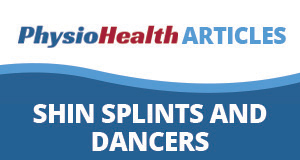
Shin splints. If you haven’t had them yourself then you undoubtedly know someone who has. Shin splints and Irish dancing seem to go hand in hand and are probably the most common reason Irish dancers spend so much time at physiotherapy clinics. Beyond knowing that they cause a lot of pain in the shin, how much do you really know about shin splints? David Micallef, an APA Sports Titled Physiotherapist from Physiohealth Melbourne who has worked with the Australian Irish Dancing Association to help them understand leg injuries and reduce the injury rate in this sport, talks through the basics.
First things first, Micallef tells us “Shin splints is an old term for shin pain, which most Sports Medical Practitioners now term ‘Medial Tibial Stress Syndrome’ (MTSS).”
Cause of Pain
According to Micallef, “The exact source of pain from MTSS is actually unknown, however there are many theories. It is commonly believed that shin pain is a continuum affecting firstly the tendons of the calf and deep toe flexor muscle groups as they attach onto the tibia (shin bone). As the syndrome deteriorates it affects the bone lining (periosteum) and eventually it can cause bone stress and eventually stress fracture of the bone. The role of the 2 calf muscles, soleus and gastrocnemius, are important factors in developing shin pain.” Ouch.
Factors causing MTSS
There are many factors involved in MTSS – Micallef explains some of the common factors are:
- Flat feet
- Poor mid-foot arch control (in standing, but also when up on toes)
- Increased training intensity
- Poor footwear
- Hard training surface
- Reduced calf endurance and strength
- Over training – not just at Irish dancing but also all other sporting activities
“Clinically the most common things I find when I assess Irish dancers is a combination of many factors, e.g. a dancer reports increased pain associated with increased training at Irish dancing, plus he or she may also have done cross country or some other jumping activity at school. This causes associated muscle fatigue and overload of the tibia. Often the dancer may spend lots of time in poor footwear such as thongs (flip flops) or [runners that don’t offer adequate support]. Often when assessed they have very tight muscles to palpate, they often cannot control the arch of their foot when standing on 1 leg, may have poor balance and foot stability especially when rising up on toes. A vicious cycle occurs when an unstable foot and a weak, fatigued calf place even greater stress on the underlying small muscles in the leg and place additional stress on the shin bone.”
Treatment
Sorry dancers, bad news on this one. “Often the best treatment for shin pain is deep massage and modified training load or rest which is certainly effective, especially in the short term”, says Micallef.
“For a longer term cure, your physiotherapist must also assess your ability to control the arch of your foot in standing and when up on toes, and guide you through a calf strengthening program, ensuring there is good foot control as well as maintaining good hip, pelvic and trunk control so that your foot is not placed under additional stress.”
While there is no obvious cause of shin pain, there is also no obvious solution. If you are having shin pain the best course of action is to be assessed by a physiotherapist. Micallef concludes, “As you can see, a good rehabilitation program will entail not only looking at the foot and shin but also calf strength, lower limb alignment and core strength to ensure you recover fully from ‘shin splints’ and stay on the dance floor.”
Have you had shin splints? How did you treat them? What advice can you share with other dancers? Share below or weigh in over on our Facebook page.
